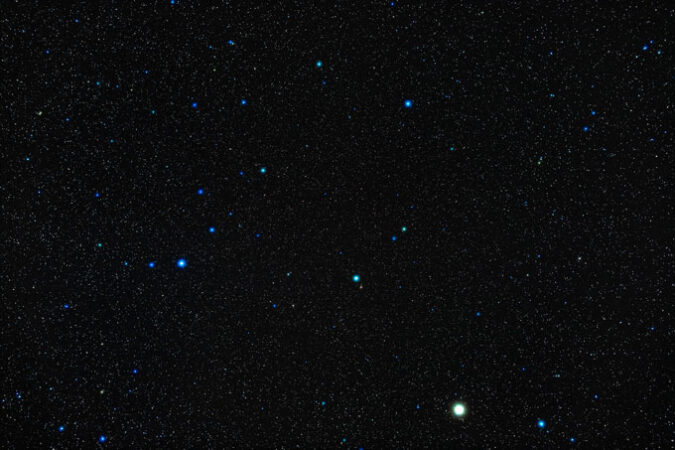A cosmic explosion this summer may add a ‘new star‘ to the night sky
Some 3,000 light-years away, this white dwarf throws off a nova eruption every 80 years or so

About 3,000 light-years away, a white-dwarf star (illustrated, left) pulls material off a nearby red-giant star (right). The buildup of matter on the white dwarf can trigger a nova eruption bright enough to see from Earth.
M. Weiss, CXC/NASA
By Jay Bennett
Stargazers may be in for a rare treat this summer. What looks like a new star could appear in the constellation Corona Borealis.
The brightening point of light will not really be a new star. It will be light from a stellar eruption called a nova and will occur in a star that’s not usually visible from Earth.
Some 3,000 light-years away, this white-dwarf star is pulling matter off a nearby red-giant star. When enough mass collects on the white dwarf’s surface, the pressure and temperature will rise. This will trigger a nova blast.
The next nova from this white dwarf is due soon. And it should be visible from Earth with the naked eye — but for only a few days to a week.
“This is a once-in-a-lifetime opportunity,” says Gerardo Juan Manuel Luna. He’s an astronomer who works at Universidad Nacional De Hurlingham in Argentina.
Where to look for the new star

The constellation Corona Borealis consists of seven stars in an arc. They looks like the letter C (toward the left in this image). In the night sky, they’re between the bright stars Vega and Arcturus. Corona Borealis is visible high overhead on summer nights in the Northern Hemisphere. And it appears close to the northern horizon in much of the Southern Hemisphere. To find Corona Borealis, trace an arcing line from the handle of the Big Dipper to Arcturus (bright spot, bottom right). Then look for the semicircle of stars nearby to the east. The nova will appear just outside this semicircle.
Going nova
The white dwarf and red giant pair are known as T Coronae Borealis, or T CrB. It’s a binary star system in which the white dwarf erupts about every 80 years. Its last nova was in 1946. The next? It’s expected by September.
What led to this forecast? In recent years, T CrB has suddenly brightened. Astronomers call this a “super active” phase. It’s been followed by an apparent dip in the star’s activity. This signals that the nova is likely coming soon. The same pattern was seen before T CrB’s novas in 1946 and 1866.
This time, scientists plan to get a better view of the light show than ever before. Dozens of telescopes around the world and in space will watch T CrB. Together, they’ll collect light from the star system at different wavelengths. These data could help unravel mysteries about novas.
“We hope to be able to answer questions with this object that then might be relevant to all the other accreting and eruptive white dwarfs,” says Jennifer Sokoloski. By accreting, this astrophysicist is referring to how one star is stealing mass from another. Sokoloski works at Columbia University in New York City.
Puzzles to solve
One big question is whether the white dwarf in T CrB gains or loses mass after each nova.
Each eruption ejects matter into space. But some of the mass that the white dwarf has ripped from the red giant may sink into the small, dense star. This could cause the white dwarf to bulk up.
If so, then repeating novas might one day lead stars like this white dwarf to undergo even bigger explosions. Such cosmic fireworks are called type 1a supernovas. They play a key role in how star systems and whole galaxies change over time.
“That’s the holy grail,” Luna says. “After the eruption — say, in the next five years when things are calmed down — we should be able to measure the [white dwarf’s] mass again. And see what happened.”
Another mystery: How will this nova’s shock waves spread through the cloud around its red-giant neighbor. Researchers want to know, too, whether dust will form in this extreme environment. That could help scientists understand where the dust comes from that forms stars and planets, Luna says.
Astronomers also will be on the lookout for high-energy gamma rays from this nova. Such energetic light was first detected from a nova in a binary star system in 2010.
“That was a complete shock,” says astrophysicist Justin Linford. He works at the National Radio Astronomy Observatory. It’s in Socorro, N.M. “Nobody in the nova community thought these things had enough energy to reach gamma-ray levels.”
Do you have a science question? We can help!
Submit your question here, and we might answer it an upcoming issue of Science News Explores
There will be little to no warning before the eruption of T CrB. Scientists can’t even be completely sure it will happen in the coming months. “Maybe we’ll sit here holding our breath for the next 10 years,” Sokoloski says.
But if T CrB’s past behavior repeats itself, then stargazers who find a dark place to view Corona Borealis at the right moment could be the first to see this cosmic spectacle.
“My bet,” Luna says, “is that this event is going to be detected by amateurs first.”







